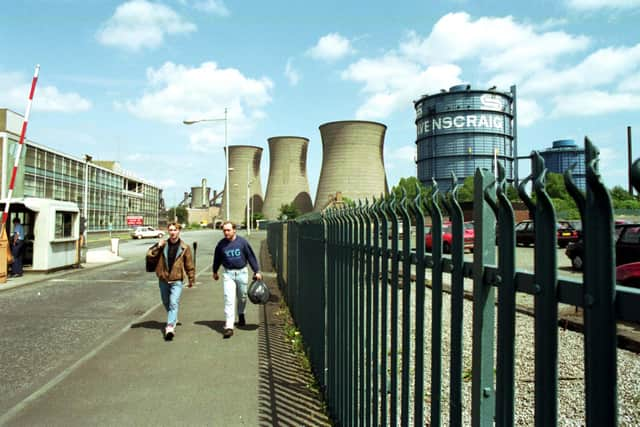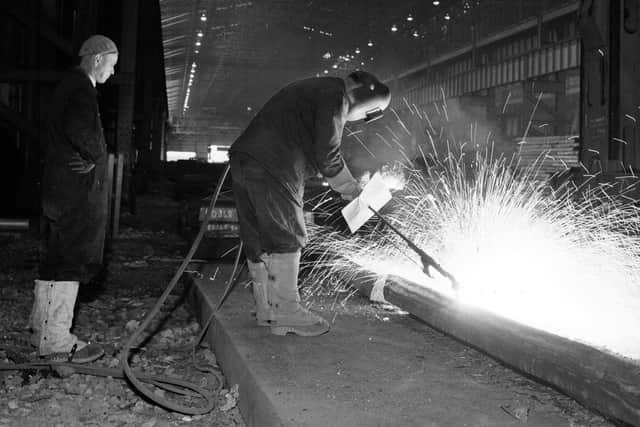We asked a Tory Minister: Why has it taken so long to reinvest in Ravenscraig?
and live on Freeview channel 276
GlasgowWorld visited the Ravenscraig site this morning, April 3, to speak with Richard Holden, a UK Transport Minister and the first ever Conservative MP for Durham North West.
The Minister - Under Secretary of State for Roads and Local Transport - was at the site to speak about a new rail-bridge, set to connect Motherwell to the development of the new-town of Ravenscraig.
Advertisement
Hide AdAdvertisement
Hide AdThe rail bridge is set to be placed in the coming days, linking the soon-to-be new-town with the town centre of Motherwell, and offering a connection from the new development to the M8.
We went down to hear about what the bridge will bring to the community, but more-so we were interested in quizzing the Conservative Transport Minister about reinvestment in the area and controversies the development is facing from within his own party.
Ravenscraig hasn’t always been a wasteland in North Lanarkshire, at one point it was the largest hot strip steel mill in Western Europe, and for a time after that it was the largest brownfield former industrial site in Western Europe.
If it wasn’t for the workers at the Lanarkshire steelworks, the ship-building industry of Glasgow wouldn’t have been possible.
Advertisement
Hide AdAdvertisement
Hide AdWe asked Richard Holden, how is the local community is set to benefit from the regeneration of the Ravenscraig site? He replied:“This is the heart [the rail bridge] of what’s happening in the project here, you’re going to see a dual carriageway right through from the M8 slap-bang into the centre of the town,which will really open up this massive former steelworks site here.
“You know I’m from a constituency which had a big steelworks in the centre of it, and it’s taken a long time for that redevelopment to start coming.
“You can see here as part of that deal - the UK Government working with the Scottish Government and the council here - bringing in over £120m; and right at the heart of this project is this 5000 ton concrete bridge going in.
“The bridge will really open up the entire space here and provide the basis for that commercial development that we want to see as part of that broader package with all the 8 councils involved and over a billion pounds coming in - but this is the major thing.
“So it should be a massive benefit for the local community.
Advertisement
Hide AdAdvertisement
Hide Ad“A leisure facility is coming in as part of that - we’re hoping soon to bring 4,500 jobs, 1000 homes will also be coming in, and there should be another 2,500 of those [new-build housing] coming in too - all moving in that one direction.”


Covering one square mile, the Ravenscraig Steelworks brought thousands of jobs to the local community, and was a source of industrial pride and heritage for decades. That was until it was closed down in 1992.
Famously at the time, the head of the Conservative Government, Margaret Thatcher, wrote that ‘no action is called for’ after being warned that the Ravenscraig had been threatened with closure, and more than 2,500 jobs were at risk.
While Glasgow was able to recover from becoming a post-industrial city, with a burgeoning service industry and nightlife after being named the ‘European City of Culture’ in 1990 - Wishaw and Motherwell weren’t as lucky.
Advertisement
Hide AdAdvertisement
Hide AdThe communities were ravaged by the loss of industry, and to this day still face issues with addiction, mental health, employment, and ‘anti-social’ behaviour.
Now 31 years later, long after the expensive copper wiring left at Ravenscraig was stripped and the industrial pollution has begun to dissipate, the Conservative Government of today hopes to bring industry back to Ravenscraig.
We asked Richard: why has it taken the Government so long to reinvest in Motherwell and Wishaw?
He said:“Well you could say the same about my own constituency and often these things do take a lot of time.
Advertisement
Hide AdAdvertisement
Hide Ad“I know there was some re-mediation work when the site closed back several decades ago now but the key thing has been what to do with this structure here - and the initial plans had been to build a bridge over the railway.
“I think this structure’s far better, you’re going to have a dual-carriageway through here, without a blight on the town centre as well.
“But I want to concentrate on the positives here, this is tens of millions of pounds of investment coming into this local community - opening up a 400 hectare site for both commercial and government development.
“You can see that with the down payment that’s been made to the local community, to the leisure facility, a great college [New College Lanarkshire Motherwell Campus, finished construction in 2010] has gone in as well.
Advertisement
Hide AdAdvertisement
Hide Ad“But also working as closely as we can with local businesses, so this is something that’s going to benefit everyone in the local area.”


We followed up on the question by asking the Transport Minister why the Ravenscraig development was overlooked in the recent ‘levelling up’ funding round.
Richard replied:“Well I mean you’ve already got that £120m coming in here now for this massive investment in development.
“Down the line we’ll have to see and I know there’s going to be further rounds of levelling up.
Advertisement
Hide AdAdvertisement
Hide Ad“My constituency also didn’t get any so it’s not unique, but what I will say is there’s already a huge amount of cash coming in here already, and massive amounts of private sector investment off the back of this investment.
“I’m sure in time I will be looking at further schemes with Government investment but also enabling private sector investment too.
“But the biggest enabler you can have is proper transport infrastructure - which allows those connections - particularly here right through from town, up to the M8 and opening up this entire massive site here.
“You can see just how big it is; and the potential there is here that’s being enabled by 10s of millions of pounds of investment from the UK and Scottish Government, and the local council as well.”
Advertisement
Hide AdAdvertisement
Hide AdPlans to build a new rail transport hub are the most controversial part of the Ravenscraig development.
A planning application submitted to build a freight line centre in the area was thrown out by North Lanarkshire Council in December of 2022 after it received around 700 objections.
The plans were opposed by fifty-eight councillors across all Scottish parties, but most interestingly, the plans were opposed by Depute-Leader of the Scottish Conservatives, Megan Gallacher.
Council planners found that the proposal was ‘wholly incompatible’ with the Ravenscraig Development Masterplan, which they set up to ensure the community was at the forefront of any plans for the new-town.
Advertisement
Hide AdAdvertisement
Hide AdWe asked Richard Holden for his thoughts on his fellow Conservative Party members’ opposition, mainly their stance that the freight centre could ‘lock out future investment’.
Richard Holden responded: “I’m really hopeful that with the mitigations that have been put in place and with this new dual carriageway going in here - that the site will really open up to the local area and to local people - and make a real difference.
“You can see the size of the site here, 400 hectares, that’s around 1000 acres of development land coming in.
“We’ve heard from the Network Rail guys here today, they said that the more this project has gone down the track - this [the rail bridge] is going in literally over the next few days - that there’s more talk of private sector investment, and they’re finding people talking about it as part of that wider project.”
Advertisement
Hide AdAdvertisement
Hide AdThe pressure group leading the charge in opposition to the freight hub are called the Ravenscraig Community Action Group, who have been following the development closely and hope to stop developers from pushing heavy industry into the Ravenscraig development.
At the moment, the developer hoping to build the freight line in Ravenscraig [Russell Group] submitted an appeal for planning permission less than 24 hours before the appeal deadline.
In response, the Ravenscraig Community Action Group announced the renewal of their campaign opposing plans for what they call a ‘dirty diesel transport hub’, or the rail freight hub, as we know it.
The community action group will hold a cross-party congress on April 28 to organise their fight against the plans.
Advertisement
Hide AdAdvertisement
Hide AdRyan O’Donnell, Chair of the Ravenscraig Community Action Group, said:“What’s at stake is the future of Motherwell – the future of North Lanarkshire.
“It’s the promise made to a generation of steel workers to build a cleaner, better future for their sons and daughters, grandsons and daughters, now great grandchildren and the families who will follow.
“Ravenscraig has a bright future, attracting investment to date in remediation, new roads, rail enhancements and active travel; in New College Lanarkshire; Ravenscraig Regional Sports Facility, a new £3.7m public park, retail, a restaurant and a thriving community of new and social homes.
“Next steps investment is gathering pace, with new council home building underway; with plans for new schools, a community hub, new retail, new housing and light industrial uses. Ravenscraig is moving forward, not back.
Advertisement
Hide AdAdvertisement
Hide Ad“We’ve joined forces with North Lanarkshire Council leaders and called a cross-party congress on April 28 to fight the plans.
“With the future of North Lanarkshire on the line, and one of the most critical points since the closure of the steelworks in 1992, now more than ever we need a strong, loud and united voice from our elected members to demand the Scottish Government reject this proposal once and for all.”
Comment Guidelines
National World encourages reader discussion on our stories. User feedback, insights and back-and-forth exchanges add a rich layer of context to reporting. Please review our Community Guidelines before commenting.
